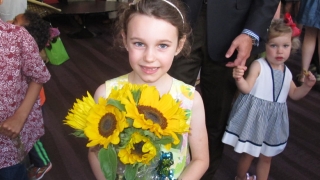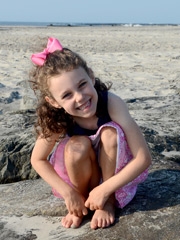Transposition of the Great Arteries: Lily’s Story
Published on
Published on
Lily was just one week old when she had heart surgery at CHOP. Today, she’s an active and caring 7-year-old. She does gymnastics and ballet, swims, sings and plays lacrosse. She loves school and learning, and is an avid reader.
 Lily has no memory of the heart surgery she underwent as a baby, but understands that doctors at Children’s Hospital of Philadelphia (CHOP) saved her life. Every year on the anniversary of her surgery, her parents take her back to CHOP to bring treats to the staff in the Cardiac Center. This year, she chose sandwiches from her favorite deli.
Lily has no memory of the heart surgery she underwent as a baby, but understands that doctors at Children’s Hospital of Philadelphia (CHOP) saved her life. Every year on the anniversary of her surgery, her parents take her back to CHOP to bring treats to the staff in the Cardiac Center. This year, she chose sandwiches from her favorite deli.
For her parents, Laura and Lee, Lily’s medical story began with a routine ultrasound 20 weeks into Laura’s pregnancy. The doctor looking at the image took longer than usual in studying it, then asked if heart defects ran in either of their families. They were sent to CHOP that same day for additional imaging and consultation with a fetal heart specialist.
They soon learned that their baby had a condition called transposition of the great arteries (TGA). The aorta and the pulmonary artery were switched, each connecting to the heart where the other should be. This meant that blood coming out of the lungs went back to the lungs, and blood coming back from the body went out to the body, without mixing. Lily would need special care at birth, and surgery soon after to correct the problem.
Arrangements were made for Laura to deliver at CHOP’s Garbose Family Special Delivery Unit (SDU), where Lily would get immediate care from the cardiac team without having to be transported from another hospital.
 “When we went home that night, we were in shock,” Laura remembers. “At first, we were asking, ‘Why us?’ But we quickly came to realize how lucky we were. It was a blessing that the problem had been discovered early. And when I started doing research, I found out that CHOP was one of the best places in the world for a child with heart problems.”
“When we went home that night, we were in shock,” Laura remembers. “At first, we were asking, ‘Why us?’ But we quickly came to realize how lucky we were. It was a blessing that the problem had been discovered early. And when I started doing research, I found out that CHOP was one of the best places in the world for a child with heart problems.”
Lily was born right on her due date. The SDU’s labor and delivery team took care of Laura while Lily was taken to the stabilization room. In the SDU, delivery rooms are connected to infant stabilization rooms where expert medical teams are ready to help babies immediately after birth.
The first step in Lily’s care was a procedure called balloon atrial septostomy, also called the Rashkind procedure, which was created at CHOP in the 1960s by Dr. William Rashkind. Using a catheter, a hole is made between the two upper chambers of the heart so that oxygenated and deoxygenated blood mixes as the heart pumps. This enabled Lily’s malformed heart to keep her body alive until surgery was done to correct the transposed arteries.
For her first week, Lily was cared for in the Cardiac Intensive Care Unit (CICU). Laura and Lee could visit her there any time, and with help from the nurses they could hold her.
The surgery was performed when Lily was a week old by Thomas Spray, MD, Chief of the Division of Cardiothoracic Surgery. To get an idea of the precision required for heart surgery on an infant, consider that Lily’s heart was the size of a walnut, and her arteries the thickness of a pen.
During the surgery, a nurse came out periodically to give Laura and Lee updates on Lily’s progress, and finally Dr. Spray came out to let them know that the procedure was finished and had been a success.
 Lily recovered wonderfully. Six hours after surgery, she drank from a bottle. She spent the next two days back in the CICU, then two more days in a step-down unit before being released to go home on day four after surgery.
Lily recovered wonderfully. Six hours after surgery, she drank from a bottle. She spent the next two days back in the CICU, then two more days in a step-down unit before being released to go home on day four after surgery.
That surgery was the last medical intervention Lily may need. A physical therapist came to the home several times a week to help her rebuild her strength and flexibility, and her parents brought her into CHOP every two months for follow-up visits that first year. She now comes in once a year.
“Lily hit every milestone,” says Laura. “She crawled early. She spoke early.” Now, at 7, she’s able to do whatever she wants to do, and that’s quite a lot — gymnastics, ballet and lacrosse this year — and more activities are expected to be added to the mix.
“Lily has taught us more already than we can ever imagine teaching her,” says Laura. “She’s so considerate and thoughtful. And we’re so grateful to CHOP for everything they have done for us.”
“She’s a wonderful caring kid,” says Lee. “I have a picture of Lily taken just after surgery with all of the tubes coming out of her. I keep it on my bedside table. It’s a reminder of everything we are grateful for. And it helps me keep things in perspective. No bad day of mine is as bad as that day for her.”
The family gives back through active participation in the Children’s Heart Foundation, which funds research into the diagnosis, treatment and prevention of congenital heart defects. And when they make their annual visit on the anniversary of Lily’s surgery, they make sure to spend time talking with parents who are going through what they went through in those first scary days after Lily’s birth. In those visits, Lily offers smiling, healthy proof that there is a bright future ahead.